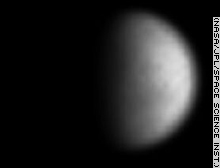The spacecraft is progressing towards entering orbit around Saturn starting on July 1st

The Cassini spacecraft took the first image of Saturn's nebulous moon Titan, revealing features on the surface, including a large bright area, known as Kando, whose nature has so far not been deciphered.
"We finally have flash images of the surface of Titan, Saturn's largest moon and the largest known uncharted land unit left in the solar system today," said Carolyn Porco, director of Cassini's imaging team at the Space Science Center.
Titan's fragile surface may contain days of methane and other hydrocarbons that remain liquid at extreme temperatures.
Because of the methane, Titan is enveloped in a thick, globular layer, and the astronomers therefore could not take a good look at the moon, which is the size of the planet Mercury (the planet Mercury). Porco imagines the "starless nights and dark days, where the midday sky looks like the last minutes of twilight on Earth.
Titan has an organic chemistry similar to that of Earth before the development of life. Scientists are eager to learn more about the moon and its composition, because they believe it may provide them with clues to the answer to the question of how life evolved from our organic soup.
The new photos were taken in mid-April. They are similar to the images taken from the largest telescopes on Earth. Purco promises an improvement in quality as the spacecraft approaches the Saturn system. Better pictures will be obtained when the sun is directly behind the spacecraft and not from the side, as it happens in the last pictures.
In two new images you can see the South Pole up to 50 degrees north. The second photo was taken after the moon had rotated 90 degrees from the position where the first photo was taken.
A large bright area in one of the images was nicknamed Xando. It may be a mountain range, a large basin, a smooth plain or a combination of all these. say the scientists. In any case, this is not an area worth living in. The temperature on Titan's surface is minus 178 degrees Celsius.
Cassini will enter orbit around Saturn on July 1 and begin exploring the planet, its rings and its many moons. On July 2, it will pass 350 kilometers from Titan (roughly the distance from the Earth to the Moon). This will be the first opportunity to see small-scale details on the moon, up to 2 kilometers in diameter.
Procto does not know how the surface will be seen. However, to penetrate the methane haze of Titan's atmosphere, the Cassini camera will use a filter designed to block all but a narrow band of near-infrared light, which is able to pass through the methane molecules. Unfortunately, she explains, this narrow-bandwidth light is punctuated by aerosols in Titan's atmosphere.
The haze, or smog, is not yet sufficiently understood. The scientists believe that it starts at an altitude of 100 kilometers above the surface and survives another 200 kilometers up. However, this hypothesis is based on a computer model and not on observations. "These types of models are often wrong," Porco pointed out.
The actual thickness of the haze layer will determine the rate at which the narrow band of sunlight in the near infrared will be fragmented as it penetrates through the atmosphere, will be reflected from the surface of Tetan and then will return to space and be picked up by the spacecraft's cameras, among other things.
At the beginning of next year, 2005, the Huygens spacecraft, which is currently a hitchhiker on Cassini, will drop through the lunar atmosphere and land on the surface, or almost certainly sink into the ocean. It will take measurements of the atmosphere and send pictures, and if all goes well it will also send pictures of the surface.
Purco envisions an earth covered in a blanket of organic matter that has condensed in the atmosphere. At higher elevations, bodies of methane washed away this material, revealing a bedrock made of ice, she says. "Random lightning storms momentarily light up the bleak surface, and wind-driven waves scour the shores of the hydrocarbon lakes and the surface-scattered seas."
Of course, we just have to wait and see.
